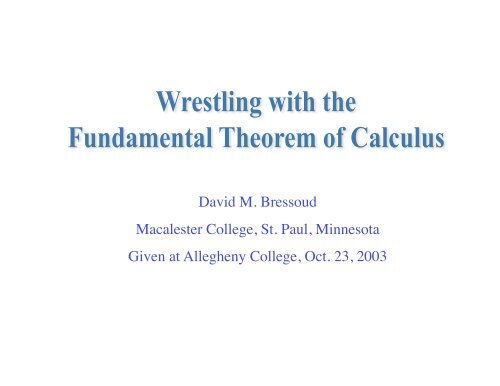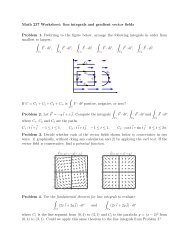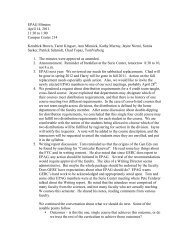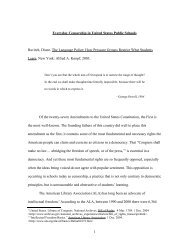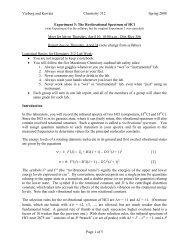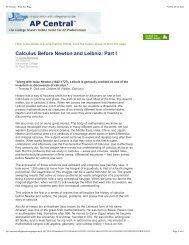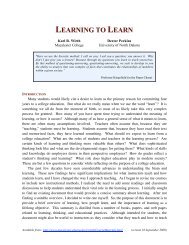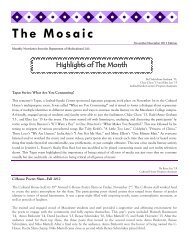Wrestling with the Fundamental Theorem of Calculus
Wrestling with the Fundamental Theorem of Calculus
Wrestling with the Fundamental Theorem of Calculus
Create successful ePaper yourself
Turn your PDF publications into a flip-book with our unique Google optimized e-Paper software.
David M. Bressoud<br />
Macalester College, St. Paul, Minnesota<br />
Given at Allegheny College, Oct. 23, 2003
The <strong>Fundamental</strong> <strong>Theorem</strong> <strong>of</strong> <strong>Calculus</strong>:<br />
1. If F' ( x)= f ( x)<br />
, <strong>the</strong>n<br />
2.<br />
d<br />
dx<br />
!<br />
x<br />
a<br />
"<br />
() = ( )<br />
f t dt f x<br />
b<br />
a<br />
( ) = ( )! ( )<br />
f x dx F b F a<br />
Are <strong>the</strong>se statements always true? What assumptions do<br />
we have to make about f and F in order for <strong>the</strong>se<br />
statements to be true?<br />
.<br />
.
S. F. LaCroix (1802):“Integral calculus is <strong>the</strong> inverse<br />
<strong>of</strong> differential calculus. Its goal is to restore <strong>the</strong><br />
functions from <strong>the</strong>ir differential coefficients.”
S. F. LaCroix (1802):“Integral calculus is <strong>the</strong> inverse<br />
<strong>of</strong> differential calculus. Its goal is to restore <strong>the</strong><br />
functions from <strong>the</strong>ir differential coefficients.”<br />
What if a function is not <strong>the</strong><br />
derivative <strong>of</strong> some identifiable<br />
function?<br />
2<br />
( )<br />
e x !
S. F. LaCroix (1802):“Integral calculus is <strong>the</strong> inverse<br />
<strong>of</strong> differential calculus. Its goal is to restore <strong>the</strong><br />
functions from <strong>the</strong>ir differential coefficients.”<br />
Joseph Fourier: Put <strong>the</strong> emphasis on definite integrals<br />
b<br />
(he invented <strong>the</strong> notation !<br />
) and defined <strong>the</strong>m in<br />
a<br />
terms <strong>of</strong> area between graph and x-axis.
S. F. LaCroix (1802):“Integral calculus is <strong>the</strong> inverse<br />
<strong>of</strong> differential calculus. Its goal is to restore <strong>the</strong><br />
functions from <strong>the</strong>ir differential coefficients.”<br />
Joseph Fourier: Put <strong>the</strong> emphasis on definite integrals<br />
b<br />
(he invented <strong>the</strong> notation ! ) and defined <strong>the</strong>m in<br />
a<br />
terms <strong>of</strong> area between graph and x-axis.<br />
How do you define area?
S. F. LaCroix (1802):“Integral calculus is <strong>the</strong> inverse<br />
<strong>of</strong> differential calculus. Its goal is to restore <strong>the</strong><br />
functions from <strong>the</strong>ir differential coefficients.”<br />
Joseph Fourier: Put <strong>the</strong> emphasis on definite integrals<br />
b<br />
(he invented <strong>the</strong> notation ! ) and defined <strong>the</strong>m in<br />
a<br />
terms <strong>of</strong> area between graph and x-axis.<br />
A.-L. Cauchy: First to define <strong>the</strong> integral as <strong>the</strong> limit<br />
<strong>of</strong> <strong>the</strong> summation<br />
( ) ( ! )<br />
f x x x<br />
" i! 1 i i!<br />
1
Bernhard Riemann (1852, 1867) On <strong>the</strong> representation<br />
<strong>of</strong> a function as a trigonometric series<br />
( ) "<br />
#<br />
! ( )<br />
i i i"<br />
1<br />
Defined f x dx as limit <strong>of</strong> f x x x<br />
!<br />
b<br />
a<br />
( )
Bernhard Riemann (1852, 1867) On <strong>the</strong> representation<br />
<strong>of</strong> a function as a trigonometric series<br />
( ) "<br />
#<br />
! ( )<br />
i i i"<br />
1<br />
Defined f x dx as limit <strong>of</strong> f x x x<br />
!<br />
b<br />
a<br />
Key to convergence: on each interval, look at <strong>the</strong><br />
variation <strong>of</strong> <strong>the</strong> function<br />
V sup f x inf f x<br />
i<br />
( )<br />
= ( )! ( )<br />
x" [ x , x ] x" [ xi! 1,<br />
xi]<br />
i! 1 i
Bernhard Riemann (1852, 1867) On <strong>the</strong> representation<br />
<strong>of</strong> a function as a trigonometric series<br />
b<br />
( ) "<br />
#<br />
! ( )<br />
i i i"<br />
1<br />
Defined f x dx as limit <strong>of</strong> f x x x<br />
!<br />
a<br />
( )<br />
Key to convergence: on each interval, look at <strong>the</strong><br />
variation <strong>of</strong> <strong>the</strong> function<br />
V sup f x inf f x<br />
i<br />
= ( )! ( )<br />
x" [ x , x ] x" [ xi! 1,<br />
xi]<br />
i! 1 i<br />
!<br />
( )<br />
Integral exists if and only if Vi xi " xi"1<br />
can be made as<br />
small as we wish by taking sufficiently small intervals.
Any continuous function is integrable:<br />
Can make V as small as we want by taking<br />
i<br />
sufficiently small intervals:<br />
# #<br />
! Vi ( xi " xi"<br />
1)< ! ( xi" xi"<br />
1)=<br />
( b" a)=<br />
#.<br />
b" a<br />
b" a
Any piecewise continuous function is integrable:<br />
If<br />
( )" ( )=<br />
lim f x lim f x J,<br />
" +<br />
x! c x! c<br />
<strong>the</strong>n take an interval <strong>of</strong> length<br />
where <strong>the</strong> variation is less than<br />
$<br />
V ( x " x )< ( J + 1) 2 1<br />
$<br />
2( J + 1)<br />
+ 1:<br />
# #<br />
i i i" 1 i i i"<br />
1<br />
J + o<strong>the</strong>r intervals<br />
$ $<br />
< + = $ .<br />
2 2<br />
<<br />
J<br />
( )<br />
( )<br />
+ V x " x
Bernhard Riemann (1852, 1867) On <strong>the</strong> representation<br />
<strong>of</strong> a function as a trigonometric series<br />
Riemann gave an example <strong>of</strong> a function that has a<br />
jump discontinuity in every subinterval <strong>of</strong> [0,1], but<br />
which can be integrated over <strong>the</strong> interval [0,1].
–2<br />
Riemann’s function:<br />
{ nx}<br />
n<br />
{}= x<br />
" $ x ! ( nearest integer ) , when this is < 1<br />
2<br />
,<br />
#<br />
%$ 0,<br />
when distance to nearest integer is 1<br />
2<br />
–1<br />
f( x)=<br />
1 2<br />
2<br />
has n jumps <strong>of</strong> size between 0 and 1<br />
n<br />
2 2<br />
!<br />
n=<br />
1<br />
{ }<br />
nx<br />
n<br />
" 2
At x = a<br />
2b<br />
, gcd ( a, 2b)= 1,<br />
<strong>the</strong> function jumps by<br />
! 2<br />
2<br />
8b
Riemann’s function: f( x)=<br />
!<br />
n=<br />
1<br />
{ }<br />
nx<br />
n<br />
" 2<br />
At x = a<br />
2b<br />
, gcd ( a, 2b)= 1,<br />
<strong>the</strong> function jumps by<br />
! 2<br />
2<br />
8b<br />
The key to <strong>the</strong> integrability is that given any positive number,<br />
no matter how small, <strong>the</strong>re are only a finite number <strong>of</strong> places<br />
where is jump is larger than that number.
If lim f' ( x) and lim f' ( x)<br />
exist,<br />
x! c x! c<br />
<strong>the</strong>n <strong>the</strong>y must be equal and <strong>the</strong>y<br />
must equal<br />
" +<br />
f' () c .<br />
Mean Value <strong>Theorem</strong>:<br />
( )! ()<br />
f x f c<br />
f'()= c lim<br />
!<br />
x" c x! c<br />
= lim<br />
!<br />
x" c<br />
f' ( k) , x < k < c<br />
f ( x)! f () c<br />
f'()= c lim = lim f' ( k) ,<br />
+ +<br />
x" c x! c x" c<br />
c < k < x
If lim f' ( x) and lim f' ( x)<br />
exist,<br />
x! c x! c<br />
<strong>the</strong>n <strong>the</strong>y must be equal and <strong>the</strong>y<br />
must equal<br />
" +<br />
f' () c .<br />
Mean Value <strong>Theorem</strong>:<br />
( )! ()<br />
f x f c<br />
f'()= c lim<br />
!<br />
x" c x! c<br />
= lim<br />
!<br />
x" c<br />
f' ( k) , x < k < c<br />
f ( x)! f () c<br />
f'()= c lim = lim f' ( k) ,<br />
+ +<br />
x" c x! c x" c<br />
c < k < x<br />
The derivative <strong>of</strong> a function cannot<br />
have any jump discontinuities!
Riemann’s function: f( x)=<br />
!<br />
n=<br />
1<br />
{ }<br />
nx<br />
n<br />
" 2<br />
At x = a<br />
2b<br />
, gcd ( a, 2b)= 1,<br />
<strong>the</strong> function jumps by<br />
! 2<br />
2<br />
8b<br />
The key to <strong>the</strong> integrability is that given any positive number,<br />
no matter how small, <strong>the</strong>re are only a finite number <strong>of</strong> places<br />
where is jump is larger than that number.<br />
Conclusion: F x f t dt<br />
x<br />
( )= ()<br />
! 0<br />
exists and is well - defined<br />
for all x, but F is not differentiable at any<br />
rational number <strong>with</strong> an even denominator.
The <strong>Fundamental</strong> <strong>Theorem</strong> <strong>of</strong> <strong>Calculus</strong>:<br />
1. If F' ( x)= f ( x)<br />
, <strong>the</strong>n<br />
f x dx F b F a<br />
2.If f does not have a jump discontinuity at<br />
x, <strong>the</strong>n<br />
d<br />
dx<br />
!<br />
x<br />
a<br />
"<br />
b<br />
a<br />
() = ( )<br />
f t dt f x<br />
( ) = ( )! ( )<br />
.<br />
.
If F is differentiable at x = a, can<br />
F '(x) be discontinuous at x = a?
If F is differentiable at x = a, can<br />
F '(x) be discontinuous at x = a?<br />
Yes!
" 2<br />
x sin ( 1 ) Fx<br />
x<br />
, x ! 0,<br />
( )= #<br />
$ 0, x = 0.
" 2<br />
x sin ( 1 ) Fx<br />
x<br />
, x ! 0,<br />
( )= #<br />
$ 0, x = 0.<br />
F' ( x)= 2x sin( 1<br />
x)! cos ( 1 ) x<br />
, x " 0.
" 2<br />
x sin ( 1 ) Fx<br />
x<br />
, x ! 0,<br />
( )= #<br />
$ 0, x = 0.<br />
F' ( x)= 2x sin( 1<br />
x)! cos ( 1 ) x<br />
, x " 0.<br />
F h F<br />
F'<br />
lim<br />
h h<br />
h<br />
lim<br />
h<br />
h h<br />
h<br />
h<br />
sin<br />
( )! ( 0)<br />
( 0)=<br />
" 0<br />
2 ( 1 )<br />
=<br />
" 0<br />
= lim sin ( 1<br />
)= 0 .<br />
h"<br />
0
" 2<br />
x sin ( 1 ) Fx<br />
x<br />
, x ! 0,<br />
( )= #<br />
$ 0, x = 0.<br />
F' ( x)= 2x sin( 1<br />
x)! cos ( 1 ) x<br />
, x " 0.<br />
F h F<br />
F'<br />
lim<br />
h h<br />
h<br />
lim<br />
h<br />
h h<br />
h<br />
h<br />
sin<br />
( )! ( 0)<br />
( 0)=<br />
" 0<br />
2 ( 1 ) x<br />
=<br />
F<br />
" 0<br />
= lim sin ( 1<br />
)= 0 .<br />
h"<br />
0<br />
lim F'x ! 0<br />
'<br />
( 0)<br />
( )<br />
does not exist, but<br />
does exist (and equals 0).
# 2x sin( 1<br />
f x<br />
x x<br />
x<br />
( )=<br />
)! cos ( 1 ) , " 0,<br />
$<br />
% 0, x = 0.<br />
Is f integrable?<br />
x<br />
% 0<br />
? " 2<br />
x sin ( 1 ) f t dt x<br />
, x ! 0,<br />
() = #<br />
$ 0, x = 0.
# 2x sin( 1<br />
f x<br />
x x<br />
x<br />
( )=<br />
)! cos ( 1 ) , " 0,<br />
$<br />
% 0, x = 0.<br />
Is f integrable?<br />
V sup f x inf f x<br />
i<br />
= ( )! ( )<br />
x" [ x , x ] x" [ xi! 1,<br />
xi]<br />
i! 1 i<br />
!<br />
( )<br />
Integral exists if and only if Vi xi " xi"1<br />
can be made as<br />
small as we wish by taking sufficiently small intervals.
# 2x sin( 1<br />
f x<br />
x x<br />
x<br />
( )=<br />
)! cos ( 1 ) , " 0,<br />
$<br />
% 0, x = 0.<br />
Is f integrable? Yes!<br />
V sup f x inf f x<br />
i<br />
= ( )! ( )<br />
x" [ x , x ] x" [ xi! 1,<br />
xi]<br />
i! 1 i<br />
!<br />
( )<br />
Integral exists if and only if Vi xi " xi"1<br />
can be made as<br />
small as we wish by taking sufficiently small intervals.
Consider:<br />
" ( ) 2 $ x sin 1 x !<br />
Fx<br />
2 , 0,<br />
( )= # x<br />
%$ 0, x = 0.<br />
( ) xsin<br />
cos , x ,<br />
F'( x)=<br />
x x x<br />
, x .<br />
! # %<br />
( ) 2 1 2 1<br />
2 2 " 0<br />
$<br />
&% 0 = 0<br />
Is F' integrable?<br />
x<br />
&0 ? " ( ) 2 $ x sin 1 , x ! ,<br />
F' () t dt = 2 0<br />
# x<br />
%$ 0, x = 0.
Consider:<br />
" ( ) 2 $ x sin 1 x !<br />
Fx<br />
2 , 0,<br />
( )= # x<br />
%$ 0, x = 0.<br />
( ) xsin<br />
cos , x ,<br />
F'( x)=<br />
x x x<br />
, x .<br />
! # %<br />
( ) 2 1 2 1<br />
2 2 " 0<br />
$<br />
&% 0 = 0<br />
Is F' integrable?<br />
x<br />
&0 ? " ( ) 2 $ x sin 1 , x ! ,<br />
F' () t dt = 2 0<br />
# x<br />
%$ 0, x = 0.<br />
No!
Consider:<br />
" ( ) 2 $ x sin 1 x !<br />
Fx<br />
2 , 0,<br />
( )= # x<br />
%$ 0, x = 0.<br />
( ) xsin<br />
cos , x ,<br />
F'( x)=<br />
x x x<br />
, x .<br />
! # %<br />
( ) 2 1 2 1<br />
2 2 " 0<br />
$<br />
&% 0 = 0<br />
Is F' integrable?<br />
x<br />
&0 ? " ( ) 2 $ x sin 1 , x ! ,<br />
F' () t dt = 2 0<br />
# x<br />
%$ 0, x = 0.<br />
But <strong>the</strong><br />
right side<br />
does equal<br />
lim F' t dt<br />
! " 0<br />
#<br />
x<br />
!<br />
()
What if <strong>the</strong> derivative, F ' , is bounded? Will <strong>the</strong><br />
derivative always be integrable?
What if <strong>the</strong> derivative, F ' , is bounded? Will <strong>the</strong><br />
derivative always be integrable?<br />
No!
“Cantor’s Set”<br />
First described by H.J.S. Smith, 1875
“Cantor’s Set”<br />
First described by H.J.S. Smith, 1875<br />
Then by Vito Volterra, 1881
“Cantor’s Set”<br />
First described by H.J.S. Smith, 1875<br />
And finally by Georg Cantor,<br />
1883<br />
Then by Vito Volterra, 1881
0<br />
Remove [1/3,2/3]<br />
Cantor’s Set<br />
1/3<br />
2/3<br />
1
Cantor’s Set<br />
0 1/9 2/9 1/3 2/3 7/9 8/9 1<br />
Remove [1/3,2/3]<br />
Remove [1/9,2/9] and [7/9,8/9]
Cantor’s Set<br />
0 1/9 2/9 1/3 2/3 7/9 8/9 1<br />
Remove [1/3,2/3]<br />
Remove [1/9,2/9] and [7/9,8/9]<br />
Remove [1/27,2/27], [7/27,8/27], [19/27,20/27], and<br />
[25/27,26/27], and so on … What’s left?
Cantor’s Set<br />
0 1/9 2/9 1/3 2/3 7/9 8/9 1<br />
1 2 4 8<br />
1!<br />
"<br />
+ + + + !<br />
$<br />
# 3 9 27 81 %<br />
1 1<br />
3 1<br />
2<br />
= ! +<br />
3<br />
" $<br />
# % + " "<br />
&<br />
#<br />
#<br />
2$<br />
3%<br />
+ "<br />
2 3<br />
#<br />
1 1 1<br />
3 1 2 = ! ( = 1! 1 = 0 .<br />
!<br />
3<br />
2$<br />
3%<br />
+<br />
$<br />
! '<br />
%<br />
What’s left has<br />
measure 0.
A set has measure 0 if for we can put <strong>the</strong> set inside a<br />
union <strong>of</strong> intervals whose total lengths are as close to 0<br />
as we wish.<br />
Examples:<br />
Any finite set has measure zero.<br />
The Cantor set has measure 0.<br />
1<br />
1 1 1 1 1 1 1 1<br />
12<br />
2<br />
2 10 2 10 4 100 4 100<br />
1 1 1 1<br />
8 1000 8 1000<br />
2 1<br />
10 1 1 !<br />
$<br />
" n n = % '<br />
)<br />
( +<br />
+<br />
#<br />
& *<br />
,<br />
2<br />
10<br />
9<br />
- ( +<br />
)<br />
+<br />
*<br />
,<br />
-<br />
)<br />
( +<br />
+<br />
*<br />
, -<br />
, , ! , ,<br />
,<br />
"<br />
total length <<br />
=<br />
(
1 1 1 1 1 1 1 1<br />
[ 0, 0. 1)( , . 99, 1]<br />
,<br />
"<br />
! 3 , +<br />
$<br />
3 ,<br />
"<br />
! 4 , +<br />
$<br />
4 ,<br />
# 2 10 2 10 % # 3 10 3 10 %<br />
"<br />
#<br />
2<br />
3<br />
" 1<br />
# 5<br />
1 2 1 1 1 1 1 3 1 3 1<br />
! 5, +<br />
$<br />
5 ,<br />
"<br />
! 6 , +<br />
$<br />
6 ,<br />
"<br />
! 7 , +<br />
$<br />
7 ,<br />
10 3 10 % # 4 10 4 10 % # 4 10 4 10 %<br />
1 1 1<br />
! 8 , +<br />
10 5 10<br />
$ 2 1 2 1 3 1 3 1<br />
,<br />
"<br />
! , +<br />
$<br />
,<br />
"<br />
! , +<br />
$<br />
,!<br />
% # 5 10 5 10 % # 5 10 5 10 %<br />
8 9 9 10 10
1 1 1 1 1 1 1 1<br />
[ 0, 0. 1)( , . 99, 1]<br />
,<br />
"<br />
! 3 , +<br />
$<br />
3 ,<br />
"<br />
! 4 , +<br />
$<br />
4 ,<br />
# 2 10 2 10 % # 3 10 3 10 %<br />
"<br />
#<br />
2<br />
3<br />
" 1<br />
# 5<br />
1 2 1 1 1 1 1 3 1 3 1<br />
! 5, +<br />
$<br />
5 ,<br />
"<br />
! 6 , +<br />
$<br />
6 ,<br />
"<br />
! 7 , +<br />
$<br />
7 ,<br />
10 3 10 % # 4 10 4 10 % # 4 10 4 10 %<br />
1 1 1<br />
! 8 , +<br />
10 5 10<br />
$ 2 1 2 1 3 1 3 1<br />
,<br />
"<br />
! , +<br />
$<br />
,<br />
"<br />
! , +<br />
$<br />
,!<br />
% # 5 10 5 10 % # 5 10 5 10 %<br />
8 9 9 10 10<br />
Every rational number in [0,1] is in at least one <strong>of</strong> <strong>the</strong>se<br />
intervals. The sum <strong>of</strong> <strong>the</strong> lengths <strong>of</strong> <strong>the</strong>se intervals is less than<br />
1 1 2 1 1<br />
+ +<br />
!<br />
3 1+<br />
+<br />
10 100 10 "<br />
2<br />
10 10<br />
11 2 10 101<br />
= + % =<br />
100 1000 9 900<br />
1<br />
+ 3<br />
10<br />
+ !<br />
#<br />
$
Base three numbers: 10211<br />
1! 1+ 1! 3 + 2 ! 9 + 0 ! 27 + 1! 81 =<br />
103<br />
1’s<br />
3’s<br />
9’s<br />
27’s<br />
81’s
Base three numbers: 10211.2012<br />
1/3’s<br />
1/9’s<br />
1/27’s<br />
1/81’s<br />
1! 1+ 1! 3 + 2 ! 9 + 0 ! 27 + 1! 81 = 103<br />
2 1 1 1 1<br />
! + 0 ! + 1! + 2 ! =<br />
3 9 27 81<br />
59<br />
81
Base three numbers: 10211.2012<br />
1/3’s<br />
1/9’s<br />
1/27’s<br />
1/81’s<br />
1! 1+ 1! 3 + 2 ! 9 + 0 ! 27 + 1! 81 = 103<br />
= 103 59<br />
81<br />
2 1 1 1 1<br />
! + 0 ! + 1! + 2 ! =<br />
3 9 27 81<br />
“tercimal number”<br />
59<br />
81
Cantor’s set eliminates all tercimals from 0.1 to 0.2.<br />
From 0.01 to 0.02 and 0.21 to 0.22<br />
From 0.001 to 0.002, 0.021 to 0.022,<br />
0.201 to 0.202, and 0.221 to 0.222<br />
Cantor’s set eliminates all tercimals that terminate or<br />
contain a 1.
Cantor’s set eliminates all tercimals from 0.1 to 0.2.<br />
From 0.01 to 0.02 and 0.21 to 0.22<br />
From 0.001 to 0.002, 0.021 to 0.022,<br />
0.201 to 0.202, and 0.221 to 0.222<br />
Cantor’s set eliminates all tercimals that terminate or<br />
contain a 1.<br />
What’s left?<br />
2 2 2 2 2 1<br />
0 02020202<br />
9 81 9 9 9 1 1 . = + + 3 + 4 + !<br />
= !<br />
"<br />
9<br />
=<br />
1<br />
4
1<br />
4<br />
The size <strong>of</strong> what’s left is still uncountable.<br />
Each element <strong>of</strong> <strong>the</strong> Cantor set corresponds to a unique<br />
number in base 2:<br />
1 1 1<br />
= 0. 020202023 ! 0. 010101012<br />
= + 2 + 3 + ! =<br />
4 4 4<br />
We get all <strong>of</strong> <strong>the</strong> base 2 numbers except those that<br />
terminate (rational numbers <strong>with</strong> denominators a power<br />
<strong>of</strong> 2).<br />
1<br />
3
The <strong>Fundamental</strong> <strong>Theorem</strong> <strong>of</strong> <strong>Calculus</strong>:<br />
1. If F' ( x)= f ( x)<br />
, <strong>the</strong>n<br />
f x dx F b F a<br />
2.If f does not have a jump discontinuity at<br />
x, <strong>the</strong>n<br />
d<br />
dx<br />
!<br />
x<br />
a<br />
"<br />
b<br />
a<br />
() = ( )<br />
f t dt f x<br />
( ) = ( )! ( )<br />
.<br />
.
Vito Volterra, 1881: There<br />
exists a function, F(x),<br />
whose derivative, F '(x),<br />
exists and is bounded for all<br />
x, but <strong>the</strong> derivative, F '(x),<br />
cannot be integrated.
Create a new set like <strong>the</strong> Cantor set except<br />
<strong>the</strong> first middle piece only has length 1/4<br />
each <strong>of</strong> <strong>the</strong> next two middle pieces only have length 1/16<br />
<strong>the</strong> next four pieces each have length 1/64, etc.<br />
" 1 2 4 2 %<br />
The amount left has size 1!<br />
$ + + + 4 + ! '<br />
# 4 16 64 4 &<br />
1 1<br />
4 1<br />
2<br />
= ! +<br />
4<br />
" " %<br />
$<br />
# # &<br />
1 1 1<br />
4 1 1 = ! (<br />
!<br />
2<br />
=<br />
1<br />
2<br />
3<br />
2<br />
+<br />
" %<br />
# 4&<br />
2 3<br />
2<br />
+<br />
" %<br />
# 4&<br />
+<br />
%<br />
!<br />
'<br />
&
We’ll call this set SVC (for Smith-Volterra-Cantor).<br />
It has some surprising characteristics:<br />
1. SVC contains no intervals - no matter how small a<br />
subinterval <strong>of</strong> [0,1] we take, <strong>the</strong>re will be points in that<br />
subinterval that are not in SVC. SVC is nowhere dense.
We’ll call this set SVC (for Smith-Volterra-Cantor).<br />
It has some surprising characteristics:<br />
1. SVC contains no intervals - no matter how small a<br />
subinterval <strong>of</strong> [0,1] we take, <strong>the</strong>re will be points in that<br />
subinterval that are not in SVC. SVC is nowhere dense.<br />
2. Given any collection <strong>of</strong> disjoint subintervals <strong>of</strong> [0,1],<br />
if <strong>the</strong> sum <strong>of</strong> <strong>the</strong> lengths is greater than 1/2, <strong>the</strong>n <strong>the</strong>y<br />
must contain at least one point in SVC.
We’ll call this set SVC (for Smith-Volterra-Cantor).<br />
It has some surprising characteristics:<br />
1. SVC contains no intervals - no matter how small a<br />
subinterval <strong>of</strong> [0,1] we take, <strong>the</strong>re will be points in that<br />
subinterval that are not in SVC. SVC is nowhere dense.<br />
2. Given any collection <strong>of</strong> disjoint subintervals <strong>of</strong> [0,1],<br />
if <strong>the</strong> sum <strong>of</strong> <strong>the</strong> lengths is greater than 1/2, <strong>the</strong>n <strong>the</strong>y<br />
must contain at least one point in SVC.<br />
3. Given any partition <strong>of</strong> [0,1] into subintervals, <strong>the</strong> sum<br />
<strong>of</strong> <strong>the</strong> lengths <strong>of</strong> <strong>the</strong> intervals that contain points in SVC<br />
will always be at least 1/2. SVC has measure 1/2.
Volterra’s construction:<br />
" 2<br />
x sin ( 1 ) Start <strong>with</strong> <strong>the</strong> function Fx<br />
x<br />
, x ! 0,<br />
( )= #<br />
$ 0, x = 0.<br />
Restrict to <strong>the</strong> interval [0,1/8], except find <strong>the</strong> largest value <strong>of</strong><br />
x on this interval at which F '(x) = 0, and keep F constant from<br />
this value all <strong>the</strong> way to x = 1/8.
Volterra’s construction:<br />
To <strong>the</strong> right <strong>of</strong> x = 1/8, take <strong>the</strong> mirror image <strong>of</strong> this<br />
function: for 1/8 < x < 1/4, and outside <strong>of</strong> [0,1/4], define<br />
this function to be 0. Call this function f x .<br />
1( )
Volterra’s construction:<br />
f x<br />
1( )<br />
is a differentiable function for all values <strong>of</strong> x, but<br />
lim f ' x and lim f ' x do not exist<br />
x!<br />
0<br />
1<br />
( ) ( )<br />
+ "<br />
1<br />
x!<br />
4<br />
1
Now we slide this function over so that <strong>the</strong> portion that<br />
is not identically 0 is in <strong>the</strong> interval [3/8,5/8], that<br />
middle piece <strong>of</strong> length 1/4 taken out <strong>of</strong> <strong>the</strong> SVC set.
We follow <strong>the</strong> same procedure to create a new<br />
function, f2( x)<br />
, that occupies <strong>the</strong> interval [0,1/16]<br />
and is 0 outside this interval.
f x<br />
2( )<br />
We slide one copy <strong>of</strong> into each interval<br />
<strong>of</strong> length 1/16 that was removed from <strong>the</strong> SVC<br />
set.
Volterra’s function, V(x), is what we obtain in <strong>the</strong> limit as<br />
we do this for every interval removed from <strong>the</strong> SVC set.<br />
It has <strong>the</strong> following properties:<br />
1. V is differentiable at every value <strong>of</strong> x, and its<br />
derivative is bounded (below by –1.013 and above by<br />
1.023).
Volterra’s function, V(x), is what we obtain in <strong>the</strong> limit as<br />
we do this for every interval removed from <strong>the</strong> SVC set.<br />
It has <strong>the</strong> following properties:<br />
1. V is differentiable at every value <strong>of</strong> x, and its<br />
derivative is bounded (below by –1.013 and above by<br />
1.023).<br />
2. If a is a left or right endpoint <strong>of</strong> one <strong>of</strong> <strong>the</strong> removed<br />
intervals, <strong>the</strong>n <strong>the</strong> derivative <strong>of</strong> V at a exists (and equals<br />
0), but we can find points arbitrarily close to a where <strong>the</strong><br />
derivative is +1, and points arbitrarily close to a where<br />
<strong>the</strong> derivative is –1.
We’ll call this set SVC (for Smith-Volterra-Cantor).<br />
It has some surprising characteristics:<br />
1. SVC contains no intervals - no matter how small a<br />
subinterval <strong>of</strong> [0,1] we take, <strong>the</strong>re will be points in that<br />
subinterval that are not in SVC. SVC is nowhere dense.<br />
2. Given any collection <strong>of</strong> disjoint subintervals <strong>of</strong> [0,1],<br />
if <strong>the</strong> sum <strong>of</strong> <strong>the</strong> lengths is greater than 1/2, <strong>the</strong>n <strong>the</strong>y<br />
must contain at least one point in SVC.<br />
3. Given any partition <strong>of</strong> [0,1] into subintervals, <strong>the</strong> sum<br />
<strong>of</strong> <strong>the</strong> lengths <strong>of</strong> <strong>the</strong> intervals that contain points in SVC<br />
will always be at least 1/2. SVC has measure 1/2.
We’ll call this set SVC (for Smith-Volterra-Cantor).<br />
It has some surprising characteristics:<br />
1. SVC contains no intervals - no matter how small a<br />
subinterval <strong>of</strong> [0,1] we take, <strong>the</strong>re will be points in that<br />
subinterval that are not in SVC. SVC is nowhere dense.<br />
2. Given any collection <strong>of</strong> disjoint subintervals <strong>of</strong> [0,1],<br />
if <strong>the</strong> sum <strong>of</strong> <strong>the</strong> lengths is greater than 1/2, <strong>the</strong>n <strong>the</strong>y<br />
must contain at least one point in SVC.<br />
3. Given any partition <strong>of</strong> [0,1] into subintervals, <strong>the</strong> sum<br />
<strong>of</strong> <strong>the</strong> lengths <strong>of</strong> <strong>the</strong> intervals that contain points in SVC<br />
will always be at least 1/2. SVC has measure 1/2.
No matter how we partition [0,1], <strong>the</strong> pieces that<br />
contain endpoints <strong>of</strong> removed intervals must have<br />
lengths that add up to at least 1/2.<br />
The pieces on which <strong>the</strong> variation <strong>of</strong> V ' is at least 2<br />
must have lengths that add up to at least 1/2.
Bernhard Riemann (1852, 1867) On <strong>the</strong> representation<br />
<strong>of</strong> a function as a trigonometric series<br />
( )<br />
!<br />
# ( ) i i " i"<br />
1<br />
Defined definite integral as limit <strong>of</strong> f x x x<br />
Key to convergence: on each interval, look at <strong>the</strong><br />
variation <strong>of</strong> <strong>the</strong> function<br />
V sup f x inf f x<br />
i<br />
= ( )! ( )<br />
x" [ x , x ] x" [ xi! 1,<br />
xi]<br />
i! 1 i<br />
!<br />
( )<br />
Integral exists if and only if Vi xi " xi"1<br />
can be made as<br />
small as we wish by taking sufficiently small intervals.
Conclusion: Volterra’s function V can be<br />
differentiated and has a bounded derivative, but its<br />
derivative, V ', cannot be integrated:<br />
d<br />
dx<br />
x<br />
V( x)= v( x) , but # v( t) dt ! V( x)" V(<br />
0.<br />
)<br />
0
The <strong>Fundamental</strong> <strong>Theorem</strong> <strong>of</strong> <strong>Calculus</strong>:<br />
1. If F has bounded variation and<br />
<strong>the</strong>n b<br />
f x dx F b F a .<br />
"<br />
a<br />
( ) = ( )! ( )<br />
F' ( x)= f ( x)<br />
,<br />
2.If f does not have a jump discontinuity at<br />
x, <strong>the</strong>n<br />
d<br />
dx<br />
!<br />
x<br />
a<br />
() = ( )<br />
f t dt f x<br />
.
The Lebesgue Integral<br />
Henri Lebesgue<br />
Ph.D. <strong>the</strong>sis: On a<br />
generalization <strong>of</strong> <strong>the</strong><br />
definite integral, 1901
( )= ( )! ( )<br />
f x 2x sin 1 1<br />
x<br />
cos<br />
x
( )= ( )! ( )<br />
f x 2x sin 1 1<br />
x<br />
cos<br />
x
( )= ( )! ( )<br />
f x 2x sin 1 1<br />
x<br />
cos<br />
x
( )= ( )! ( )<br />
f x 2x sin 1 1<br />
x<br />
cos<br />
x
( )= ( )! ( )<br />
f x 2x sin 1 1<br />
x<br />
cos<br />
x
( )= ( )! ( )<br />
f x 2x sin 1 1<br />
x<br />
cos<br />
x
With Lebesgue’s definition, <strong>the</strong> derivative <strong>of</strong><br />
Volterra’s function is integrable.<br />
<strong>Theorem</strong> If f ' exists and is bounded on [a,b], <strong>the</strong>n<br />
f ' is integrable (in <strong>the</strong> Lebesgue sense) and<br />
"<br />
b<br />
a<br />
() = ( )! ( )<br />
f ' t dt f b f a .<br />
<strong>Theorem</strong> If f is integrable on [a,b], <strong>the</strong>n<br />
d<br />
dx<br />
!<br />
x<br />
a<br />
measure 0.<br />
() = ( )<br />
f t dt f x<br />
, except, possibly, on a set <strong>of</strong>


